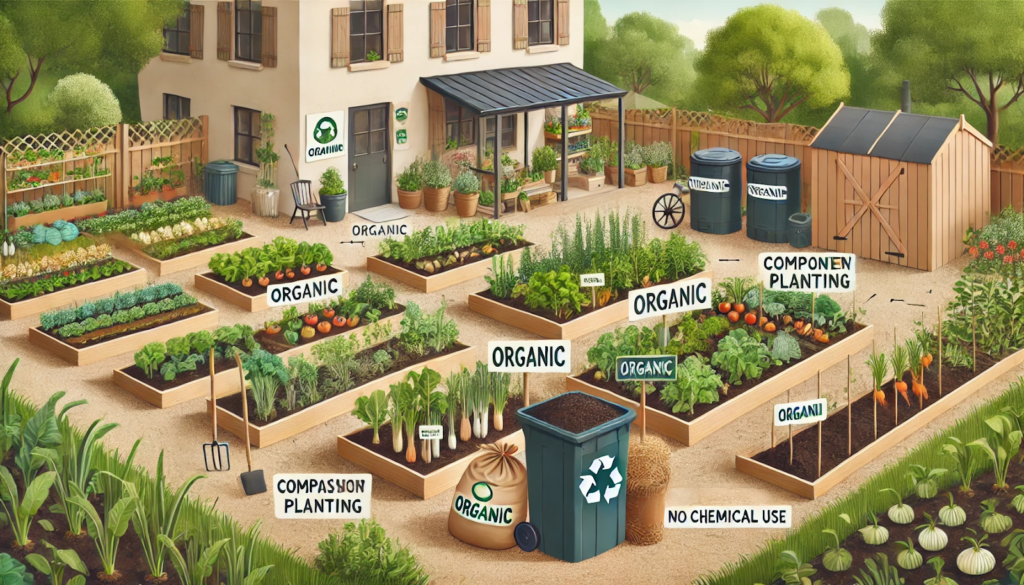Organic gardening is a method of growing plants without synthetic fertilizers, pesticides, or genetically modified organisms. It focuses on working with nature to build healthy soil, support biodiversity, and grow food sustainably.
Whether you’re planting vegetables, herbs, or flowers, starting an organic garden at home is easier than you think. This guide will walk you through the core principles and practical steps to grow organically in your own space.
1. What Is Organic Gardening?
Organic gardening means growing plants using natural methods that prioritize soil health, plant diversity, and ecological balance.
Key Principles:
- Feed the soil, not just the plant
- Use compost and natural fertilizers
- Control pests naturally (not chemically)
- Avoid synthetic herbicides and GMOs
- Support pollinators and beneficial insects
Organic gardening is about sustainability, not perfection.
2. Start with Healthy, Living Soil
Healthy soil is the foundation of any organic garden. It supplies nutrients, holds water, and supports beneficial microbes.
How to Build Healthy Soil:
- Add organic compost made from food scraps or yard waste
- Use natural mulch like straw or leaves to retain moisture
- Avoid synthetic fertilizers that harm soil life
- Rotate crops to avoid nutrient depletion
Investing in your soil pays off with stronger, more resilient plants.
3. Choose Organic or Heirloom Seeds and Plants
Start your garden with seeds or seedlings that haven’t been treated with chemicals.
Where to Find Them:
- Certified organic seed suppliers
- Local farmers markets
- Seed exchanges or community gardens
Heirloom varieties are also popular in organic gardening for their flavor, diversity, and seed-saving potential.
4. Compost: Turn Waste into Soil Gold
Composting is a key practice in organic gardening. It reduces waste and creates nutrient-rich soil amendments.
What to Compost:
- Fruit and veggie scraps
- Coffee grounds and tea bags
- Eggshells
- Grass clippings and dry leaves
What to Avoid:
- Meat, dairy, and oily foods
- Diseased plant material
- Pet waste
Turn your compost regularly and keep it balanced between green (wet) and brown (dry) materials.
5. Water the Organic Way
Watering properly ensures healthy roots and reduces disease risk.
Best Practices:
- Water in the early morning or late afternoon
- Use a drip irrigation system or soaker hose
- Mulch around plants to conserve moisture
- Collect rainwater in barrels for an eco-friendly source
Avoid watering the leaves—focus on the soil near the roots.
6. Practice Companion Planting
Some plants help each other grow, naturally improving pest resistance and soil health.
Examples:
- Tomatoes + Basil = flavor boost + pest deterrent
- Carrots + Onions = repel each other’s pests
- Corn + Beans + Squash = traditional “Three Sisters” method
This method reduces the need for chemical controls.
7. Use Organic Pest Control Methods
Organic gardening avoids synthetic pesticides in favor of natural pest control.
Natural Solutions:
- Neem oil or insecticidal soap for soft-bodied insects
- Diatomaceous earth for crawling pests
- Introduce beneficial insects like ladybugs and lacewings
- Use floating row covers to protect seedlings
Prevention is key—keep your plants healthy and diverse to avoid outbreaks.
8. Fertilize with Natural Materials
Skip the chemical fertilizers and feed your plants with slow-release, organic options.
Organic Fertilizers:
- Compost
- Aged manure
- Fish emulsion
- Seaweed extract
- Bone meal and blood meal
Apply according to plant needs and growth stages.
9. Rotate Crops Each Season
Crop rotation keeps soil nutrients balanced and reduces disease buildup.
Example Plan:
- Year 1: Leafy greens
- Year 2: Fruit crops (like tomatoes)
- Year 3: Root vegetables
- Year 4: Legumes (beans/peas to fix nitrogen)
Keep a garden journal to track rotations and performance.
10. Embrace Biodiversity and Natural Beauty
Organic gardens thrive when they mimic natural ecosystems.
Include:
- Flowering herbs and pollinator plants
- Native species adapted to your climate
- A mix of perennials and annuals
- Wildlife-friendly spaces like bee hotels and water bowls
Your garden becomes a healthy, balanced habitat—not just for food, but for life.
Conclusion: Grow the Natural Way
Organic gardening is a journey, not a destination. With time, observation, and care, your garden will become more productive, sustainable, and beautiful. Whether you’re growing food, flowers, or both, organic methods ensure you’re working with nature—not against it.
Start small, grow what you love, and let your garden thrive the natural way.






